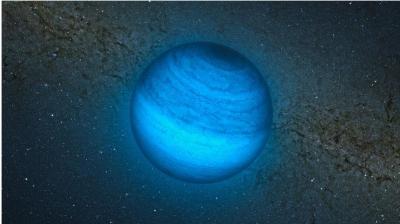
You may have seen headlines earlier this week about a planet found wandering alone, without a star to orbit. Although that aspect of the new planetary find seems to have grabbed the headlines, it's actually one of the least interesting features of the new find. The body in question awkwardly straddles the border between near-stars called brown dwarfs and giant super-Jupiter class planets, and its features suggest it may have formed through a process identical to one that creates stars. The alternative—that it was ejected from a system of planets that formed orbiting a star—would suggest interstellar space is teeming with rogue planets.
Rogue planets, those that aren't gravitationally bound to a star, have been identified previously through surveys looking for a phenomenon called "microlensing." This occurs when the planet acts as a gravitational lens, briefly brightening a star in the background as the planet passes between the star and Earth. A survey of microlensing objects identified a number of possible planets that mapped to points in space where there were no stars in the neighborhood.
But in this case, the authors managed to directly image one relatively nearby (less than 140 light years away). It happened while they were looking for something else: brown dwarfs. These bodies are large enough to have ignited deuterium fusion (over 13 times the mass of Jupiter), but not large enough to have kicked off sustained fusion of hydrogen. Anything below the brown dwarf cutoff is considered a planet (with the largest of these gas giants typically termed "super Jupiters").
Although that makes for a nice, exact definition of what constitutes a planet, it actually may obscure a more relevant distinction. Normally, we think of stars as forming through the collapse of a gas cloud; planets form through an aggregation of material within the disks that typically surround a star. But as the authors note, that distinction is being challenged by a number of rogue, sub-stellar objects likely to have formed through a process similar to how stars are produced.
When the authors came across CFBDSIRJ214947.2-040308.9 (CFBDSIR2149 to its friends), it first looked like a brown dwarf gradually losing its heat after having ended fusion a while back. But a careful analysis of the light emitted by the object suggested a possible alternative: it was small, too small to have ever undergone fusion. Instead, the heat given off by the object was residual energy from the gravitational collapse of its formation. Further supporting a young age, the researchers found the object appeared to be associated with a small cluster of stars that were all relatively young, between 50 and 120 million years of age.
Based on the composition of the stars and the object's atmospheric properties, the authors conclude it's probably only four to seven times the mass of Jupiter. That's far too small to have ever initiated fusion.
Because it's not associated with any stars, the authors were able to get some detailed information about its atmosphere, spotting indications of methane and potassium in its gaseous envelope. They suggest further observations could use CFBDSIR2149 as an example exoplanet to prepare for the direct imaging of objects orbiting nearby stars. The details we get from those studies could also help us refine the models we have of exoplanet atmospheres.
Given its young age and lack of clear association with any other stars, the authors conclude it probably formed through the collapse of a star-forming gas cloud, rather than within a planetary disk. And if that's the case, they suggest we might want to revisit a lot of the other objects that were initially described as brown dwarfs. It may turn out that some of these actually fall into the planetary mass range. There have been a couple other reports of planet sized objects that formed this way, but we haven't really incorporated this into our models for star formation (the paper suggests that the same sort of fragmentation of gas clouds that leads to binary systems can take place on a smaller scale).
The alternative explanation for this class of object (which the authors call an isolated planetary mass object, or IPMO) is ejection from a system of planets formed from a planetary disk. Models of orbital dynamics suggest this is possible, either due to interactions among planets or the influence of a nearby star. But it should be much harder to eject a super Jupiter-sized planet. So if these large IPMOs are common, smaller ones should be much, much more common (a trend enhanced by the fact smaller planets form in larger numbers). "This would mean," the authors conclude, "free-floating, frozen-down versions of Jupiters, Neptunes, and perhaps Earths are common throughout the Milky Way interstellar ranges."
Astronomy & Astrophysics, 2012. DOI: 10.1051/0004-6361/201219984 (About DOIs).
reader comments
70